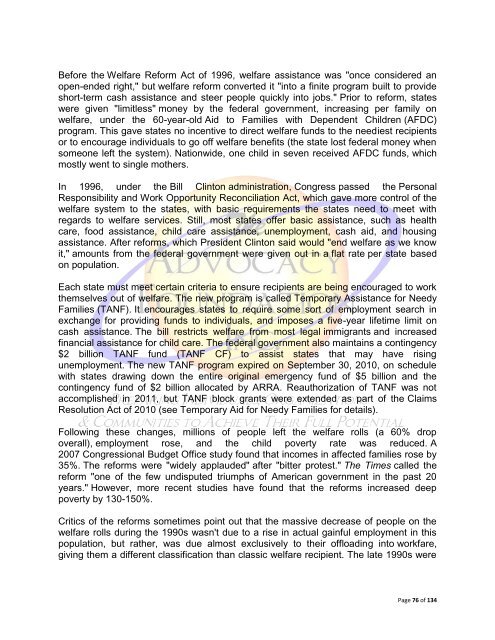Concentrated Poverty
Concentrated Poverty
Concentrated Poverty
Create successful ePaper yourself
Turn your PDF publications into a flip-book with our unique Google optimized e-Paper software.
Before the Welfare Reform Act of 1996, welfare assistance was "once considered an<br />
open-ended right," but welfare reform converted it "into a finite program built to provide<br />
short-term cash assistance and steer people quickly into jobs." Prior to reform, states<br />
were given "limitless" money by the federal government, increasing per family on<br />
welfare, under the 60-year-old Aid to Families with Dependent Children (AFDC)<br />
program. This gave states no incentive to direct welfare funds to the neediest recipients<br />
or to encourage individuals to go off welfare benefits (the state lost federal money when<br />
someone left the system). Nationwide, one child in seven received AFDC funds, which<br />
mostly went to single mothers.<br />
In 1996, under the Bill Clinton administration, Congress passed the Personal<br />
Responsibility and Work Opportunity Reconciliation Act, which gave more control of the<br />
welfare system to the states, with basic requirements the states need to meet with<br />
regards to welfare services. Still, most states offer basic assistance, such as health<br />
care, food assistance, child care assistance, unemployment, cash aid, and housing<br />
assistance. After reforms, which President Clinton said would "end welfare as we know<br />
it," amounts from the federal government were given out in a flat rate per state based<br />
on population.<br />
Each state must meet certain criteria to ensure recipients are being encouraged to work<br />
themselves out of welfare. The new program is called Temporary Assistance for Needy<br />
Families (TANF). It encourages states to require some sort of employment search in<br />
exchange for providing funds to individuals, and imposes a five-year lifetime limit on<br />
cash assistance. The bill restricts welfare from most legal immigrants and increased<br />
financial assistance for child care. The federal government also maintains a contingency<br />
$2 billion TANF fund (TANF CF) to assist states that may have rising<br />
unemployment. The new TANF program expired on September 30, 2010, on schedule<br />
with states drawing down the entire original emergency fund of $5 billion and the<br />
contingency fund of $2 billion allocated by ARRA. Reauthorization of TANF was not<br />
accomplished in 2011, but TANF block grants were extended as part of the Claims<br />
Resolution Act of 2010 (see Temporary Aid for Needy Families for details).<br />
Following these changes, millions of people left the welfare rolls (a 60% drop<br />
overall), employment rose, and the child poverty rate was reduced. A<br />
2007 Congressional Budget Office study found that incomes in affected families rose by<br />
35%. The reforms were "widely applauded" after "bitter protest." The Times called the<br />
reform "one of the few undisputed triumphs of American government in the past 20<br />
years." However, more recent studies have found that the reforms increased deep<br />
poverty by 130-150%.<br />
Critics of the reforms sometimes point out that the massive decrease of people on the<br />
welfare rolls during the 1990s wasn't due to a rise in actual gainful employment in this<br />
population, but rather, was due almost exclusively to their offloading into workfare,<br />
giving them a different classification than classic welfare recipient. The late 1990s were<br />
Page 76 of 134

















